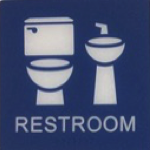How often when you go to a public building on business do you need to use a restroom? In fact, it’s probably the most visited location in the building! So let’s acknowledge the restroom’s importance as a major destination. That means that signs that direct to and identify restrooms need to meet high standards of visibility, usability and accessibility.
Let’s start out where we always should, with “sensible.” It’s sensible to make restroom signs readable and usable for everyone because that’s one place in the building that everyone needs to find. That includes people who can’t read text, or maybe can’t see at all. And that means that ADA rules for signs need to be followed.
It also means that we should consider going beyond the minimum requirements. It is sensible to add pictograms, because we know those are a big help to people with cognitive or intellectual disabilities. If a gender term is used, then a simple gender pictogram is appropriate. If the room is named “Restroom,” then staying away from gender symbols makes more sense.
So that covers the sensible basics. Now let’s talk about what not to do, and why. This gets into a discussion of what is most “gender sensitive.”
As there is more recognition that everyone does not fit neatly into just two never changing gender categories, states are beginning to grapple with the fact that there is a need for restrooms for people of different gender expressions. California is dealing with the issue by dictating that all single user restrooms be non-gender specific.
So, what does that mean for restroom signs? We have seen many signs with very creative gender symbols as well as some with very lengthy messages. But if the restrooms are for any gender, or no gender, then why refer to gender at all? No matter what symbol we design, it is apt to be confusing. Symbols take a long time to become universally recognized. Some of the attempts could seem downright insulting. If you have seen the half-man, half-woman pictogram, you know what we mean! And who wants to read, when rushing to find a restroom, “Non-gender specific restroom. You are welcome to use this restroom no matter what your gender expression.”
There are other attempts that include combinations of male and female symbols. Shorter, but also more than anyone needs to know: “Non-gender Specific Restroom.” So — how to think about restroom signs for facilities that anyone can use? Think simple, think straightforward, think non-gender! And how to achieve that?
First, just call these single user rooms “Restroom.” With no gender indicated, it’s obvious that anyone may use this facility. As for a pictogram, we recommend a simple representation of a toilet (i.e. water closet or WC) and a lavatory. It’s clear to anyone who can see, including those who don’t read English or read at all, what the room is.
The only other addition could be the International Symbol of Accessibility, and we recommend the original “Stick Guy/Gal” that is federally approved. It is one of the most recognized symbols in the entire world. Even if all restrooms in the building are accessible, it is a good addition to a single user restroom that is large enough for two people to use.
Isn’t it great to have a simple answer to what may seem like a complicated problem? For single user restrooms, we call them that: Restroom. We use a simple pictogram with a toilet and lavatory, and possibly add the ISA, or International Symbol of Accessibility. Sensible and sensitive are taken care of, and our energies can be directed at making sure the signs follow the ADA standards and are readable and usable for everyone.

The latest "Words of Wisdom" from the ADA Sign Lady
Sensible and Gender-Sensitive Accessible Restroom Signs
How to think about them, and how to achieve them!



